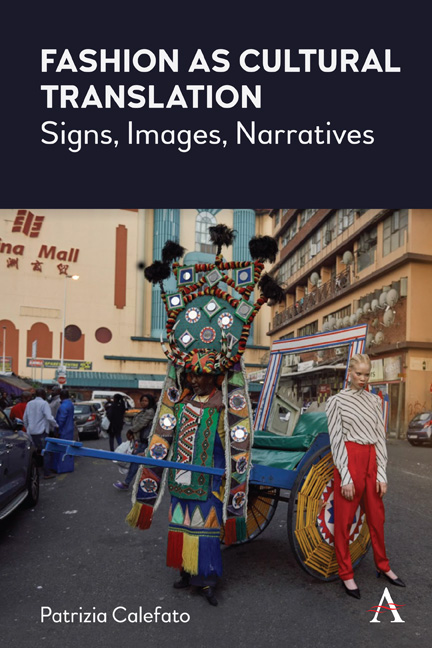Book contents
- Frontmatter
- Contents
- Introduction: Fashion as Cultural Translation in the Hyperconnected World
- Supplement to the Introduction: Fashion, the Hyperconnected World and Coronavirus
- 1 Time
- 2 Spaces
- 3 Fashion as Cultural Tradition: Italian Style
- 4 Fashion as Cultural Translation
- 5 Clothed Bodies
- 6 The Body as Text
- 7 Humans and Beyond
- 8 Fashion and the ‘Second Nature’
- 9 Fashion, Communication and Converging Media
- 10 Fashion Narratives in Visual Culture
- Conclusions: Fashion as an Idea about the Future
- References
- Index
Introduction: Fashion as Cultural Translation in the Hyperconnected World
Published online by Cambridge University Press: 18 February 2021
- Frontmatter
- Contents
- Introduction: Fashion as Cultural Translation in the Hyperconnected World
- Supplement to the Introduction: Fashion, the Hyperconnected World and Coronavirus
- 1 Time
- 2 Spaces
- 3 Fashion as Cultural Tradition: Italian Style
- 4 Fashion as Cultural Translation
- 5 Clothed Bodies
- 6 The Body as Text
- 7 Humans and Beyond
- 8 Fashion and the ‘Second Nature’
- 9 Fashion, Communication and Converging Media
- 10 Fashion Narratives in Visual Culture
- Conclusions: Fashion as an Idea about the Future
- References
- Index
Summary
In his book Modernity at Large (1996), Indian anthropologist Arjun Appadurai introduces an interesting conceptualisation of fashion wherein he describes it as an essential notion to understand forms of consumption, duration and history from an anthropological and sociological perspective. Appadurai observes:
In general, all socially organized forms of consumption seem to revolve around some combination of the following three patterns: interdiction, sumptuary law, and fashion. (Appadurai 1996, 71)
By using terms such as ‘interdiction’ and ‘sumptuary law’, Appadurai refers to forms of restriction of consumption, including taboos, duties and bans which many societies have coded in their written laws. Fashion is instead perceived as the model of forms of consumption – extended from the perspective of both quality and quantity – which pertain primarily (albeit not exclusively) to the field of clothing and which activate – as Appadurai observes through Mauss's words – ‘techniques of the body’ (Ibid., 67). Thus, the ‘generalized shift from the reign of sumptuary law to the reign of fashion‘(72) represents that ‘cluster of events’ which Appadurai defines a ‘consumer revolution’. This revolution has taken place in many different societies at different times and under different historical circumstances. These conjunctures are not tied exclusively to the model which prevails in Europe; instead, they are engendered within a ‘multiplication of scenarios’, where ‘the rest of the world will not simply be seen as repeating, or imitating, the conjunctural precedents of England or France’ (73).
Why do I believe that Appadurai's vision is relevant to understand fashion as a form of cultural translation? Of course, it is rather limiting to look at fashion only within the sphere of consumption, especially today, as Appadurai himself seems to imply when he writes that ‘the idea of consumer revolution is itself in some ways inadequate to the electronic present’ (72) and we will find out in the following chapters. However, while I keep this limitation in mind, and while I look at this issue 25 years after Modernity at Large was published, what I consider essential in Appadurai's understanding is the global vision of fashion as a phenomenon which cannot be merely ‘analysed’ within different social scenarios and culture, but as one which instils the very notion of culture with pluralism and complexity. In other words, the object – or the system – of fashion mobilises an articulate and mobile disciplinary gaze.
- Type
- Chapter
- Information
- Fashion as Cultural TranslationSigns, Images, Narratives, pp. vii - xivPublisher: Anthem PressPrint publication year: 2021



